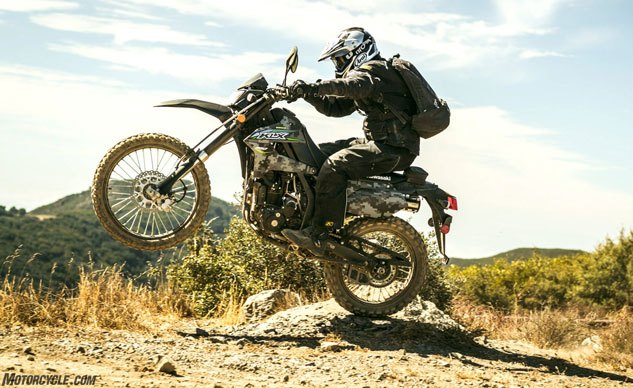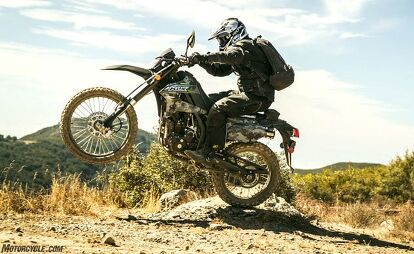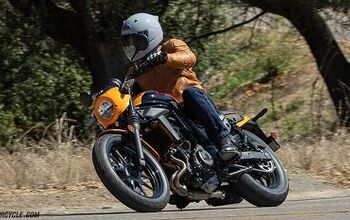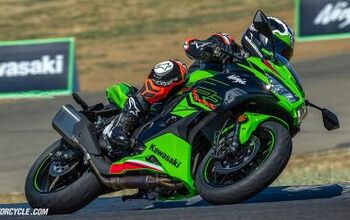2018 Kawasaki KLX250 First Ride Review
Adventure within reach of small legs and small budgets
In the 1960s and early ’70s, small dual-sport bikes were a common and affordable way for new riders to enter into the world of motorcycling. Today sees a resurgence in the tiddler dual-purpose bikes, with Honda recently offering up its updated CRF250L ($5,149, plus $330 destination charge) and the mechanically similar CRF250L Rally, an adventure-styled quarter-liter mount. Yamaha continues to sell its higher-spec WR250R, which offers greater performance but at an inflated price ($6,699).
2018 Kawasaki KLX250
| Engine | 17.0/20 |
| Suspension/Handling | 13.5/15 |
| Transmission/Clutch | 9.0/10 |
| Brakes | 8.0/10 |
| Instruments/Controls | 3.5/5 |
| Ergonomics/Comfort | 9.0/10 |
| Appearance/Quality | 8.0/10 |
| Desirability | 7.0/10 |
| Value | 9.0/10 |
| Overall Score | 84/100 |
Related: 2017 Honda CRF250L Rally First Ride Review
Now comes along a freshened KLX250 from Kawasaki after a three-year hiatus, ringing in at $5,349 for the lime green color option. The worst aspect of the previous model was its lean carburetion that resulted in difficult starting and imprecise throttle responses. Addressing that issue is a fuel-injection system utilizing a 10-hole injector that delivers easier starting and improved performance while purportedly consuming less fuel. The EFI system has actually been available in overseas markets for several years.
Related: 2018 Kawasaki KLX250 Announced
Related: 2013 Honda CRF250L vs. 2013 Kawasaki KLX250S
The last time (2013) we tested a KLX250, it spat out 24.0 hp at 8200 rpm to its rear wheel, with 13.5 lb-ft of torque produced at 7100 revs. The addition of injection to the DOHC, 4-valve motor yields livelier throttle response, but its output is still quite tame. Kawasaki fitted the KLX’s gearbox with a revised shift drum designed to offer greater precision when shifting through its six cogs. Swapping gears takes only a light effort, and a fairly easy clutch pull doesn’t tire hands.
Short riders new to motorcycling might be intimidated by the KLX’s 35.0-inch seat height, but a the bike’s narrow midsection and its springs settling under a rider’s weight reduces foot reach considerably. A benefit of the tallish seat is a considerable amount of legroom that will be slow to cramp long legs. When its 2.0-gallon tank is filled, Kawi claims the Klixxer scales in at a reasonable 304 pounds. The CRF250L is claimed to weigh 317.5 pounds with its 2.1-gallon tank full.
The KLX has always had a suspension advantage over its lower-end Japanese rivals, with more travel and adjustable damping, and that holds true today. The KLX’s shock offers 16 levels of compression- and rebound-damping adjustment as well as spring preload, while the 43mm inverted cartridge fork settles for 16 steps of compression damping variance but no rebound adjustment. The CRF250L’s boingers are non-adjustable aside from the shock’s preload. The Kawi’s front and rear suspension travel is listed at 10.0 and 9.1 inches, respectively, which closely compares with the CRF’s 9.6 and 9.4 inches.
Related: KLX250S In 2008 Lightweight Dual-Purpose Shootout
The KLX comports itself well around town, with its injected motor offering enough jump to stay ahead of car traffic if desired. Highway cruising is fairly painless, with the counterbalanced 249cc Single dishing out performance adequate to achieve 80+ mph, although it’s happier at 70. The KLX’s 21-inch front wheel and semi-knobby tires feel a bit odd out on the streets, but the bike’s lithe nature easily heeds the commands of its pilot. Steering responses are quick but always predictable and linear, and a shove on its wide handlebar ensures snappy reactions when needed.
Riding a dual-sport significantly multiplies the places where a motorcycle can be ridden, allowing off-road excursions whenever dirt opportunities present themselves. Our ride on the updated KLX nicely illustrated the horizon-expanding capabilities of lightweight, off-road-capable machines by pointing us into the Santa Ana Mountains, an uninhabited area that feels a million miles away from the concrete-encrusted Orange Country in SoCal despite being right next to it.
The only paved route over the range is Ortega Highway, which is regularly jammed with cars commuting between Riverside and OC counties. Our route took us to the end of Silverado Canyon, at which point became a two-track dirt road with challenging but fun twists through the mountains until emerging north of Lake Elsinore. Despite this riding area being so close to my OC digs, I had never ridden this route.
The KLX250 shines in this environment. The Kawi’s light weight and willing maneuverability makes even mediocre dirt riders feel in control on difficult terrain. There were several sections with rocks and sand that would be extremely challenging on a large-displacement adventure bike but were relatively undemanding on the little KLX.
Dual-purpose Dunlop D605 tires seem a good compromise of street security and dirt grip. Rear traction is enhanced by the engine’s mild output. First gear is low enough to slowly crawl through nearly anything, with a fairly large gap to a tallish second gear that provides a wide range of speeds – almost 90% of our off-roading was spent in second. As a KLX owner, I’d be inclined to somehow hot-rod this motor to provide a bit more snap.
Suspension performance is better than I expected, with admirable compliance without feeling too loose. While it would be insufficient for gnarly hits, it is nicely dialed in for the type of off-roading for which the KLX is intended, and I felt no need to adjust the factory settings during our ride. It handled rock hits without much deflection, and it made street bumps virtually disappear. Excel aluminum wheel rims remained undented despite several poor line choices in rocky terrain.
The KLX’s footpegs and the rear brake pedal are cleated to ensure boot grip even when muddy, and a folding shift lever nub alleviates a bent lever in a tip-over. A skidplate between the lower frame rails protects the engine sump from obstacles larger than the bike’s generous 11.2 inches of ground clearance.
A twin-piston caliper bites on a 250mm front wave rotor to provide good speed retardation. Only one finger is needed when riding in the dirt. A single-piston caliper is matched with 240mm rear rotor which proved a bit too aggressive when braking in off-road situations, locking prematurely in low-traction situations. ABS is unavailable on the KLX.
The LCD instrument panel remains as previous, offering a bar-graph tach, dual tripmeters and a clock. A gear-position display would be a nice addition, as would a fuel gauge. Although the KLX’s fuel tank holds just 2.0 gallons, the bike’s 60+ mpg fuel burn should enable a range of more than 120 miles. Its gas cap has the convenient flip-top design with a lock.
Conclusion
The return of the KLX250 to Kawasaki’s lineup is well-timed for the contemporary moto market, offering a proven platform on which to enable the establishment of riding skills for newbies and adequate performance for more experienced riders. Taller newbs who feel cramped on small-displacement sportbikes will find the KLX’s much-rangier ergos much more accommodating.
Most illuminating to me, though, is the horizon-expanding capabilities of lightweight dual-sports like the affordable KLX250. It can adeptly handle commuting and city traffic as well as allowing fun and challenging adventures off-road. Perhaps it’s time to again look toward the dual-sport category for a versatile way to get new riders into the world of motorcycling.
2018 Kawasaki KLX250
+ Highs
- Versatile and affordable fun
- Easy to ride
- Quality suspension and brakes
– Sighs
- Underwhelming power
- Touchy rear brake
- Feeling inadequate next to GS BMWs
Specifications | 2018 Kawasaki KLX250S | 2017 Honda CRF250L |
|---|---|---|
| Engine Type | Liquid-cooled, fuel-injected DOHC, 4-Valve Single | Liquid-cooled, fuel-injected, DOHC, Single |
| Bore x Stroke | 72.0mm x 61.2mm | 76.0mm x 55.0mm |
| Compression Ratio | 11.0:1 | 10.7:1 |
| Fueling | Kawasaki DFI; 34mm throttle body | PGM-FI; 38mm throttle body |
| Ignition | Digital DC-CDI | Full transistorized ignition |
| Transmission | Six-speed | Six-speed |
| Final Drive | Chain | Chain |
| Front Suspension | 43mm inverted cartridge fork with 16-step compression damping adjustment, 10.0 in. travel | 43mm Showa telescopic inverted fork; 9.6 in. travel |
| Rear Suspension | Uni-Trak with adjustable preload, 16-step compression and rebound damping adjustment, 9.1 in. travel | Pro-Link, Showa single shock; 9.4 in. travel |
| Front Brake | Single 250mm petal disc w/twin-piston caliper (ABS not an option) | Single 256mm disc w/Nissin twin-piston caliper (ABS optional) |
| Rear Brake | 240mm petal disc w/single-piston caliper (ABS not an option) | Single 220mm disc w/Nissin single-piston caliper (ABS optional) |
| Front Tire | Dunlop D605F 3.00 x 21-inch | IRC Trails GP 3.00 x 21-inch |
| Rear Tire | Dunlop D605 4.60 x 18-inch | IRC Trails GP 120/80-18 |
| Rake | 26.5° | 27.6° |
| Trail | 4.1 inches | 113mm (4.4 inches) |
| Seat Height | 35.0 inches | 34.4 inches |
| Ground Clearance | 11.2 inches | 10.0 inches |
| Wheelbase | 56.3 inches | 56.9 inches |
| Fuel Capacity | 2.0 gal. | 2.1 gal. |
| Claimed Curb Weight | 304 lbs. | 317.5 lbs. |
| Color | Lime Green or Camo | Red |
| MSRP | $5,349 (Lime Green), $5,549 (Camo) | $5,149 (add $300 for ABS model) |
More by Kevin Duke































































































Comments
Join the conversation
I like that manufacturers are making small displacement MC's for street and dirt. However, they are just a tad TOO small. A 350 sized Kawa like this might be a good start. Actually, I'm puzzled as to why we don't see a proper single cylinder thumper for the off road bikes. Wouldn't a nice 500 thumper be nice? Torquey. Simple. Narrow.
I feel a bit like Goldilocks. Looking for that one bike. A KLR 500. Diesel of course.
They had to know the KLR650 was on its way out from the lineup. I wonder why they didn't try to make this a better middle ground dualsport and throw the Ninja 400 engine into either this or the Versys-X 300. Can I wish upon a star for A Versys-X 650 that's just the factory version of the KLR-Sys I've seen online?